

Original Article - Year 2009 - Volume 24 -
Comparative study between omphaloplasty techniques
Estudo comparativo entre técnicas de onfaloplastia
ABSTRACT
Introduction: The formation of pathological scar in omphaloplasty compromises the result of the abdominoplasty. Many techniques have been proposed with the objective to prevent such unfavorable evolution. Method: Seventy five patients submitted to abdominoplasty successively had been placed, randomized, into two groups. The first group (n=38) was composed for three circular techniques and the second group (n=37) by three non-circular techniques. The results had been analyzed with one, two, four and six postoperative months, concerning the presence of cicatricial hypertrophy or stenosis, the subjective satisfaction of the patients and the satisfaction of the surgeon (based in the incidence of the other criteria). The statistic analysis was carried through with the accurate test of Fisher (significant for p < 0.05). Results: By the end of six months, in the group of circular techniques, seven (18.2%) patient kept stenosis, eight (22.2%) said themselves unsatisfied with the aspect of the umbilical scar, and in the evaluation of the surgeon, nine (23.7%) patients presented inadequate result. In the group of the non-circular techniques, one (2.7%) patient kept stenosis, one (2.7%) said herself unsatisfied, and in the evaluation of the surgeon, five (13.6%) patients presented inadequate result. The use of non-circular techniques showed significant difference concerning the satisfaction of the patient (p=0.0286) and almost significant (p=0.0561) concerning the formation of stenosis. The use of circular techniques showed a relative risk seven times bigger in the prevalence of stenosis. All other parameters had not shown significant difference between the groups. Conclusion: The non-circular techniques of omphaloplasty, in this casuistry, have provided greater satisfaction to the patients. The comparison of several parameters between different techniques of omphaloplasty contributes for the elaboration of an ideal drawing of scar.
Keywords: Umbilicus/surgery. Plastic surgery. Outcome assessment.
RESUMO
Introdução: A formação de cicatriz patológica na onfaloplastia compromete o resultado da abdominoplastia. Várias técnicas foram propostas com o objetivo de evitar tal evolução desfavorável. Método: Setenta e cinco pacientes submetidas a abdominoplastia foram sucessivamente alocadas, alternadamente, em dois grupos. O primeiro grupo (n=38) era composto por três técnicas circulares e o segundo grupo (n=37) por três técnicas não-circulares. Os resultados foram analisados com um, dois, quatro e seis meses pós-operatórios, quanto à presença de hipertrofia ou estenose cicatricial, à satisfação subjetiva da pacientes e à satisfação do cirurgião (baseada na incidência dos demais critérios). A análise estatística foi realizada com o teste exato de Fisher (significativo para p < 0,05). Resultados: Ao fim de seis meses, no grupo de técnicas circulares, sete (18,2%) pacientes mantinham estenose, oito (22,2%) diziam-se insatisfeitas quanto ao aspecto da cicatriz umbilical, e, na avaliação do cirurgião, nove (23,7%) pacientes apresentavam resultado inadequado. No grupo das técnicas não-circulares, uma (2,7%) paciente manteve estenose, uma (2,7%) dizia-se insatisfeita e, na avaliação do cirurgião, cinco (13,6%) pacientes apresentavam resultado inadequado. O uso de técnicas não-circulares mostrou diferença significativa quanto à satisfação da paciente (p=0,0286) e quase significativa (p=0,0561) quanto à formação de estenose. O uso de técnicas circulares mostrou risco relativo sete vezes maior na prevalência de estenose. Os demais parâmetros não mostraram diferença significativa entre os grupos. Conclusão: As técnicas não-circulares de onfaloplastia, nesta casuística, proporcionaram maior satisfação às pacientes. A comparação de vários parâmetros entre diferentes técnicas de onfaloplastia contribui para a elaboração de um desenho ideal de cicatriz.
Palavras-chave: Umbigo/cirurgia. Cirurgia plástica. Avaliação de resultados.
O reposicionamento da cicatriz umbilical na parede abdominal pode comprometer o bom resultado da abdominoplastia, ao produzir cicatrizes visíveis e com formato pouco natural. O resultado cirúrgico pode ser melhorado com a obtenção de uma cicatriz bem posicionada, com profundidade e forma adequadas.
O umbigo tem formato mais oval e verticalmente orientado em mulheres jovens e magras. Idealmente, o umbigo deve possuir um arco superior de dobra de pele que encobre levemente a cicatriz umbilical1. Na região periumbilical, há menor quantidade de tecido gorduroso, conferindo um aspecto deprimido.
Em mulheres obesas, o umbigo se torna mais alargado e profundo com o acúmulo de gordura periumbilical. Por outro lado, umbigos extremamente pequenos também são considerados esteticamente desagradáveis2.
Na abdominoplastia deve-se exteriorizar a cicatriz umbilical em forma mais natural e agradável possível3. A eversão do retalho e a lipectomia peri-incisional contribuem para a depressão da cicatriz resultante e a formação de pele em torno dela4.
A formação de cicatriz hipertrófica, quelóide ou contratura cicatricial em uma cicatriz circular pode provocar a estenose umbilical. Várias técnicas foram propostas na literatura com o objetivo de evitar esta evolução desfavorável,1,5-9.
Nesse trabalho, objetivamos comparar diferentes técnicas de onfaloplastia, considerando a satisfação quanto ao resultado, o resultado do umbigo e a formação de hipertrofia e estenose cicatricial.
MÉTODO
Foram avaliadas 75 pacientes, do sexo feminino, submetidas a abdominoplastia em nosso serviço, entre janeiro de 2006 e setembro de 2007, quanto à técnica de onfaloplastia e seu resultado estético.
Foram utilizadas seis técnicas de onfaloplastia divididas em dois grupos: técnicas circulares e não-circulares. As pacientes foram sucessivamente alocadas, de modo alternado, em técnicas de cada um dos grupos.
Em todas as técnicas foi realizada a marcação respectiva na pele do retalho abdominal e incisada sobre a cicatriz umbilical da paciente. A seguir foi evertido o retalho e realizada a ressecção de gordura peri-incisional. A cicatriz umbilical foi fixada pela derme à borda da fáscia dos músculos reto abdominais, em seus quatro pontos cardinais.
O primeiro grupo (n=38) era composto por três técnicas circulares (Figura 1):
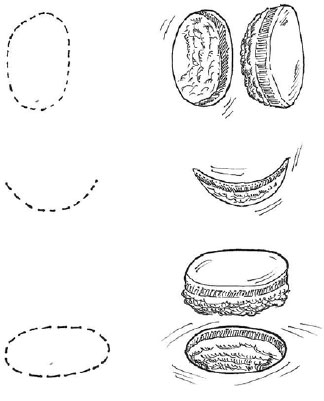
Figura 1 - Técnicas circulares.
O segundo grupo (n=37) era composto por três técnicas não-circulares (Figura 2):
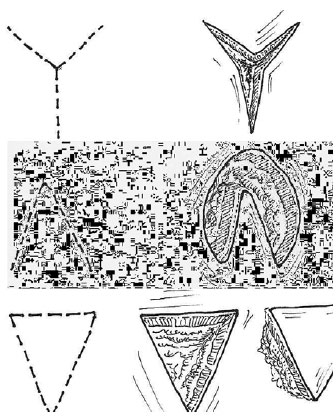
Figura 2 - Técnicas não-circulares.
Os resultados foram analisados no pós-operatório imediato, com um mês, dois, quatro e seis meses pós-operatórios, quanto ao formato regular do umbigo, à presença de hipertrofia ou estenose cicatricial (Figura 3), à satisfação subjetiva da pacientes e à satisfação do cirurgião (baseada na incidência dos demais critérios).
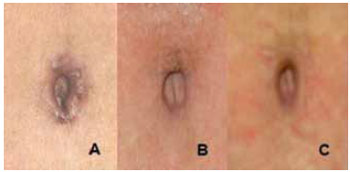
Figura 3 - A: hipertrofia cicatricial; B: estenose cicatricial; C: hipertrofia e estenose cicatricial.
Na vigência de hipertrofia ou estenose, o tratamento inicial foi realizado com órtese de silicone e massagem com corticóide tópico. Caso não houvesse melhora após um mês, associava-se a aplicação mensal intralesional de corticóide.
A análise estatística foi realizada com o teste exato de Fisher, em tabela de contingência, e calculado valor de p (significância para p menor do que 0,05).
RESULTADOS
No grupo das técnicas circulares, com um mês de pós-operatório, houve nove casos de hipertrofia (3 casos em cada técnica) e 2 casos de estenose isolada (oval vertical) e alteração no formato do umbigo em 6 pacientes (2 de cada técnica). Com dois meses de pós-operatório, houve um novo caso de hipertrofia e um de estenose (oval vertical). No quarto mês, houve dois casos de umbigos grandes (oval vertical e "U" alargado). Aos seis meses, sete pacientes mantinham estenose umbilical, a despeito do tratamento instituído (Tabela 1).

Neste grupo, ao fim de seis meses, oito pacientes diziam-se insatisfeitas quanto às dimensões da cicatriz umbilical. Na avaliação do cirurgião, nove pacientes apresentavam resultado inadequado (Tabela 2).
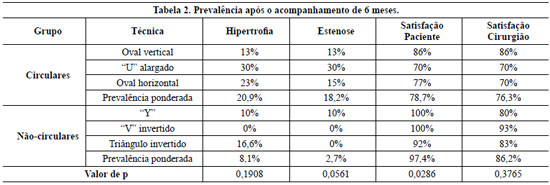
No grupo das técnicas não-circulares, com um mês de pós-operatório, houve quatro casos de hipertrofia (1 caso em "Y" e 3 casos em "V" invertido) e 2 casos de estenose isolada ("V" invertido) e um caso de umbigo grande ("V" invertido). Com dois meses de pós-operatório, houve três novos casos de hipertrofia (triângulo invertido) e dois de estenose ("Y" e triângulo invertido). No quarto mês, houve dois novos casos de hipertrofia ("Y"). Aos seis meses, três pacientes mantinham estenose umbilical, a despeito do tratamento instituído (Tabela 1).
Quanto à satisfação subjetiva das pacientes após seis meses, uma paciente queixou-se de sua cicatriz umbilical neste grupo. Na avaliação do cirurgião, cinco pacientes apresentavam resultado inadequado (Tabela 2).
A análise estatística mostrou diferença significativa quanto à satisfação da paciente (p=0,0286) após 6 meses, e quase significativa (p=0,0561) quanto à formação de estenose, porém com um risco relativo de 7,0 na prevalência deste critério no uso de técnicas circulares ao fim dos 6 meses. Os demais parâmetros analisados não mostraram significância estatística (Figura 4).
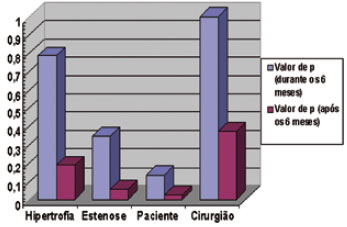
Figura 4 - Comparação dos valores de p.
DISCUSSÃO
Na abdominoplastia, o adequado posicionamento e formato da cicatriz umbilical são muito importantes para um resultado satisfatório.
Diferentes técnicas têm sido propostas para conseguir uma cicatriz com aspecto natural e esteticamente agradável. A avaliação de vários parâmetros do resultado para técnicas diferentes contribui para a escolha de um formato ideal de onfaloplastia.
As técnicas não-circulares evitam o surgimento de anel cicatricial com deformidade da cicatriz umbilical, como as técnicas semelhantes descritas na literatura1,5-9.
A comparação entre incidência e prevalência de hipertrofia e estenose no período analisado mostrou que a ocorrência destes é independente da técnica utilizada (ausência de significância estatística), porém as técnicas circulares apresentaram um risco relativo sete vezes maior de formação de estenose. As técnicas não-circulares responderam melhor ao tratamento instituído do que as técnicas circulares, devido à diferença maior na comparação entre elas quanto à prevalência do que quanto à incidência.
Na avaliação de seis meses de pós-operatório, o grupo das técnicas que evitaram cicatrizes circulares mostrou maior porcentagem de formato adequado e de satisfação quanto ao resultado em comparação ao grupo das técnicas com cicatrizes de exteriorização com formatos circulares com diferença estatística significante quanto à satisfação da paciente.
A diferença de satisfação entre cirurgião e paciente pode ser devido ao fato que as pacientes apresentam maior tolerância e consequente satisfação subjetiva às cicatrizes constritas do que às alargadas, apesar de ambas serem consideradas resultados inadequados na avaliação do cirurgião.
CONCLUSÃO
As técnicas não-circulares de onfaloplastia, nesta casuística, proporcionaram maior satisfação às pacientes. A comparação de vários parâmetros do resultado de diferentes técnicas de onfaloplastia contribui para elaboração de um desenho de cicatriz com resultado mais próximo do ideal, com consequente satisfação de paciente e cirurgião.
REFERÊNCIAS
1. Malic CC, Spyrou GE, Hough M, Fourie L. Patient satisfaction with two different methods of umbilicoplasty. Plast Reconstr Surg. 2007;119(1):357-61.
2. Craig SB, Faller MS, Puckett CL. In search of the ideal female umbilicus. Plast Reconstr Surg. 2000;105(1):389-92.
3. Schoeller T, Wechselberger G, Otto A, Rainer C, Schwabegger A, Lille S, et al. New technique for scarless umbilical reinsertion in abdominoplasty procedures. Plast Reconstr Surg. 1998;102(5):1720-3.
4. Baroudi R, Keppke EM, Netto FT. Abdominoplasty. Plast Reconstr Surg. 1974;54(2):161-8.
5. Delerm A. Refinements in abdominoplasty with emphasis on reimplantation of the umbilicus. Plast Reconstr Surg. 1982;70(5): 632-7.
6. Ramirez OM. Abdominoplasty and abdominal wall rehabilitation: a comprehensive approach. Plast Reconstr Surg. 2000;105(1): 425-35.
7. Juri J, Juri C, Raiden G. Reconstrution of the umbilicus in abdominoplasty. Plast Reconstr Surg. 1979;63(4):580-2.
8. Viterbo F. The H technic in omphaloplasty. Rev Paul Med. 1988;106(2):85-8.
9. Pigossi N, Tariki JY, Cássia H, Calonge F, Andrade AC, Misawa HT, et al. Tactics in the umbilical approach in abdominoplasties. Rev Hosp Clin Fac Med São Paulo. 1991;46(3):145-7.
I. Membro associado da Sociedade Brasileira de Cirurgia Plástica (SBCP).
II. Residente do Instituto de Cirurgia Plástica Santa Cruz.
III. Membro associado da SBCP, Assistente do Instituto de Cirurgia Plástica Santa Cruz.
IV. Membro titular da SBCP, Assistente do Instituto de Cirurgia Plástica Santa Cruz.
V. Membro titular da SBCP, Regente do Instituto de Cirurgia Plástica Santa Cruz.
Correspondência para:
Marina Junqueira Ferreira Rosique
Rua Ouvidor Peleja, 98, Apt 54 - Vila Mariana
São Paulo, SP - CEP 04128-000
E-mail: marininhajunqueira@yahoo.com.br
Trabalho realizado no Instituto de Cirurgia Plástica Santa Cruz, São Paulo, SP. Trabalho apresentado como tema livre no 2° Congresso do DESC, realizado em São Paulo, SP, em 23 de fevereiro de 2008.
Artigo recebido: 11/1/2009
Artigo aceito: 22/3/2009


 Read in Portuguese
Read in Portuguese
 Read in English
Read in English
 PDF PT
PDF PT
 Print
Print
 Send this article by email
Send this article by email
 How to Cite
How to Cite
 Mendeley
Mendeley
 Pocket
Pocket
 Twitter
Twitter